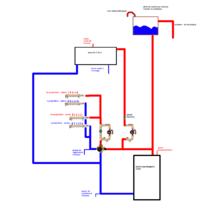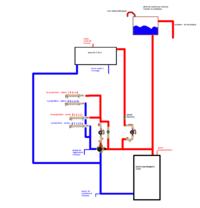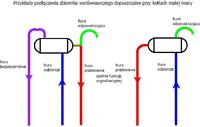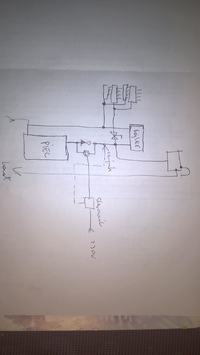Hello,
I am asking someone who is knowledgeable in the subject to assess the correctness of the attached scheme of the CO + CWU installation
Open installation, all-flammable boiler (mainly coal, walnut and wood) 25kW. Boiler room in the basement, heated ground floor + part of the 1st floor, a total of approx. 140m2. Everything on radiators, without a floor.
The main part of the installation (all 'thick' lines in the diagram) is 28mm copper. From manifolds to 16mm PEX radiators.
The expansion vessel will be open about 5-6m above the boiler.
Basic questions:
1. Would the installation be safe?
2. Is something missing / too much?
3. Are the pipe diameters in the installation appropriate?
4. Which version will be more correct and why? In the first version, the pump and the differential valve are connected to the same four-way valve output, in the second version the differential valve is before the four-way valve, and the pump at the four-way valve output.
I will be grateful for your help


I am asking someone who is knowledgeable in the subject to assess the correctness of the attached scheme of the CO + CWU installation
Open installation, all-flammable boiler (mainly coal, walnut and wood) 25kW. Boiler room in the basement, heated ground floor + part of the 1st floor, a total of approx. 140m2. Everything on radiators, without a floor.
The main part of the installation (all 'thick' lines in the diagram) is 28mm copper. From manifolds to 16mm PEX radiators.
The expansion vessel will be open about 5-6m above the boiler.
Basic questions:
1. Would the installation be safe?
2. Is something missing / too much?
3. Are the pipe diameters in the installation appropriate?
4. Which version will be more correct and why? In the first version, the pump and the differential valve are connected to the same four-way valve output, in the second version the differential valve is before the four-way valve, and the pump at the four-way valve output.
I will be grateful for your help






